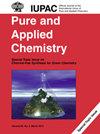全民绿色化学:全纳绿色和可持续化学教育的三项原则
IF 2
4区 化学
Q3 CHEMISTRY, MULTIDISCIPLINARY
引用次数: 0
摘要
介绍了 "全纳绿色可持续化学教育"(IGSCE)的三大原则,以指导思考、设计和实 施潜在的全纳教材和方法。这些原则是指:(i) 接受以学生为中心的学习;(ii) 促进化学五级表征的教学;(iii) 调整课程,通过支持性教学和社会指导,使学生能够将其学术技能有效地应用到现实生活中。确定并讨论了有利于潜在全纳课堂的教育要素及其相互联系。其中包括使用三角双金字塔隐喻法(TBM)来促进学术上的全纳性,无论残疾与否,如聋人和盲人。此外,还强调了确保所有学生,无论其能力如何,都能充分参与教育体验的重要性,这与实现全纳教育和终身学习机会的可持续发展目标 4(SDG #4)是一致的。绿色化学应面向所有人,而不仅仅是少数人。绿色化学促进可持续发展,值得全球认可和支持。IGSCE 这三项原则所针对的变革推动者包括但不限于教育工作者、研究人员、教师以及中学和大学教育中的学生。本文章由计算机程序翻译,如有差异,请以英文原文为准。
Green chemistry for all: three principles of Inclusive Green and Sustainable Chemistry Education
The three principles of Inclusive Green and Sustainable Chemistry Education (IGSCE) are presented to guide the reflection, design, and implementation of potentially inclusive materials and approaches. These principles refer to (i) embracing student-centered learning, (ii) promoting teaching in the five levels of representation in chemistry, and (iii) adapting the curriculum to empower students to apply their academic skills effectively to real-life situations through supportive teaching and social guidance. Educational elements conducive to potentially inclusive classrooms and their interconnections are identified and discussed. These include using the Triangular Bipyramid Metaphor (TBM) to facilitate academic inclusivity for individuals with and without disabilities, such as those who are deaf and blind. Further, the importance of ensuring that all students, regardless of their abilities, can fully participate in the educational experience is highlighted, aligning with Sustainable Development Goal 4 (SDG #4) to achieve inclusive education and lifelong learning opportunities. Green chemistry should be available to everyone, not just a few. It promotes sustainable development and deserves global recognition and support. The change agents targeted by these three principles of IGSCE include, but are not limited to, educators, researchers, teachers, and students in secondary and university education.
求助全文
通过发布文献求助,成功后即可免费获取论文全文。
去求助
来源期刊

Pure and Applied Chemistry
化学-化学综合
CiteScore
4.00
自引率
0.00%
发文量
60
审稿时长
3-8 weeks
期刊介绍:
Pure and Applied Chemistry is the official monthly Journal of IUPAC, with responsibility for publishing works arising from those international scientific events and projects that are sponsored and undertaken by the Union. The policy is to publish highly topical and credible works at the forefront of all aspects of pure and applied chemistry, and the attendant goal is to promote widespread acceptance of the Journal as an authoritative and indispensable holding in academic and institutional libraries.
 求助内容:
求助内容: 应助结果提醒方式:
应助结果提醒方式:


